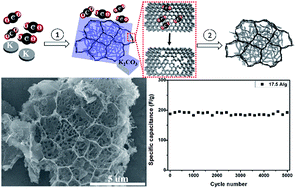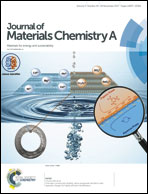Direct conversion of CO2 to meso/macro-porous frameworks of surface-microporous graphene for efficient asymmetrical supercapacitors†
Abstract
CO2 conversion to useful materials is the most attractive approach to control its content in the atmosphere. An ideal electrode material for supercapacitors should possess suitable meso/macro-pores as electrolyte reservoirs and rich micro-pores as places for the adsorption of electrolyte ions. Herein, we designed and synthesized such an ideal material, meso/macro-porous frameworks of surface-microporous graphene (MFSMG), from CO2via its one-step exothermic reaction with potassium. Furthermore, the MFSMG electrode exhibited a high gravimetric capacitance of 178 F g−1 at 0.2 A g−1 in 2 M KOH and retained 85% capacitance after increasing current density by 50 times. The combination of the MFSMG electrode and the activated carbon (AC) electrode constructed an asymmetrical AC//MFSMG capacitor, leading to a high capacitance of 242.4 F g−1 for MFSMG and 97.4 F g−1 for AC. With the extended potential, the asymmetrical capacitor achieved an improved energy density of 9.43 W h kg−1 and a power density of 3504 W kg−1. This work provides a novel solution to solve the CO2 issue and creates an efficient electrode material for supercapacitors.



 Please wait while we load your content...
Please wait while we load your content...